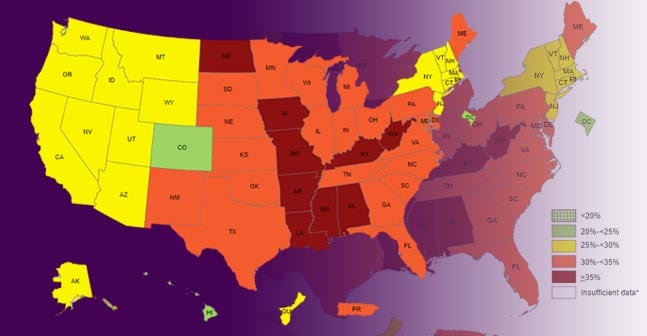 |
| Map of those overweight and obese by state. |
Life expectancy is continuing to rise in other advanced, wealthy nations, including the liberal European nations so derided by American conservatives. Such is not the case in the United States where life expectancy is falling, with sharp decreases in age brackets often considered the prime time of one's life. A report published in the Journal of the American Medical Association looks at the unwanted reality and where the death rate has risen the most: mostly in mid-western "swing states" and the South, regions where Republican political rule predominates. While no one cause explains the phenomenon, there are a number of factors noted in the report, particularly, America's obesity problem. Go to Europe and walk around almost any city and you will NOT see the large numbers of overweight people and those you do see will most often be American tourists. My own thoughts on this particular problem of obesity focuses on (i) Americans' poor diet and addiction to high calorie fast food and (ii) vastly over-sized portions at American restaurants (things you do not see in Europe). Then, of course, most other advanced nations have some version of universal health care, something lacking in the USA. The Washington Post looks at the report and the dire outlook for the future. Here are article highlights:
Death rates from suicide, drug overdoses, liver disease and dozens of other causes have been rising over the past decade for young and middle-aged adults, driving down overall life expectancy in the United States for three consecutive years, according to a strikingly bleak study published Tuesday that looked at the past six decades of mortality data.The report, published in the Journal of the American Medical Association, was immediately hailed by outside researchers for its comprehensive treatment of a still-enigmatic trend: the reversal of historical patterns in longevity.
Despite spending more on health care than any other country, the United States has seen increasing mortality and falling life expectancy for people age 25 to 64, who should be in the prime of their lives. In contrast, other wealthy nations have generally experienced continued progress in extending longevity.
[T]he broad trend detailed in this study cuts across gender, racial and ethnic lines. By age group, the highest relative jump in death rates from 2010 to 2017 — 29 percent — has been among people age 25 to 34.
The findings are sure to fuel political debate about causes and potential solutions because the geography of rising death rates overlaps to a significant extent with states and regions that are hotly contested in the run-up to the 2020 presidential election.
About a third of the estimated 33,000 “excess deaths” that the study says occurred since 2010 were in just four states: Ohio, Pennsylvania, Kentucky and Indiana — the first two of which are critical swing states in presidential elections. The state with the biggest percentage rise in death rates among working-age people in this decade — 23.3 percent — is New Hampshire, the first primary state.
“It’s supposed to be going down, as it is in other countries,” said the lead author of the report, Steven H. Woolf, director emeritus of the Center on Society and Health at Virginia Commonwealth University. “The fact that that number is climbing, there’s something terribly wrong.”
He said many factors are at play. The opioid epidemic is a major driver of the worrisome numbers but far from the sole cause. The study found that improvements in life expectancy, largely because of lower rates of infant mortality, began to slow in the 1980s, long before the opioid epidemic became a national tragedy.
“Some of it may be due to obesity, some of it may be due to drug addiction, some of it may be due to distracted driving from cellphones,” Woolf said. Given the breadth and pervasiveness of the trend, “it suggests that the cause has to be systemic, that there’s some root cause that’s causing adverse health across many different dimensions for working-age adults.”
The average life expectancy in the United States fell behind that of other wealthy countries in 1998, and since then the gap has grown steadily. Experts refer to this gap as the United States’ “health disadvantage.”
Princeton professors Anne Case and Angus Deaton, whose much-publicized report in 2015 highlighted the death rates in middle-aged whites, published a paper in 2017 pointing to a widening gap in health associated with levels of education, a trend dating to the 1970s. Case told reporters their research showed a “sea of despair” in the United States among people with only a high school diploma or less.
Obesity is a significant part of the story. The average woman in the United States today weighs as much as the average man half a century ago, and men now weigh about 30 pounds more. Most people in the United States are overweight — an estimated 71.6 percent of the population age 20 and older, according to the CDC. That figure includes the 39.8 percent who are obese, defined as having a body mass index of 30 or higher in adults (18.5 to 25 is the normal range). Obesity is also rising in children; nearly 19 percent of the population age 2 to 19 is obese.
“These kids are acquiring obesity in their early teen years, sometimes under the age of 10,” said S. Jay Olshansky, a professor of public health at the University of Illinois at Chicago. “When they get up into their 20s, 30s and 40s, they’re carrying the risk factors of obesity that were acquired when they were children. We didn’t see that in previous generations.”
No comments:
Post a Comment